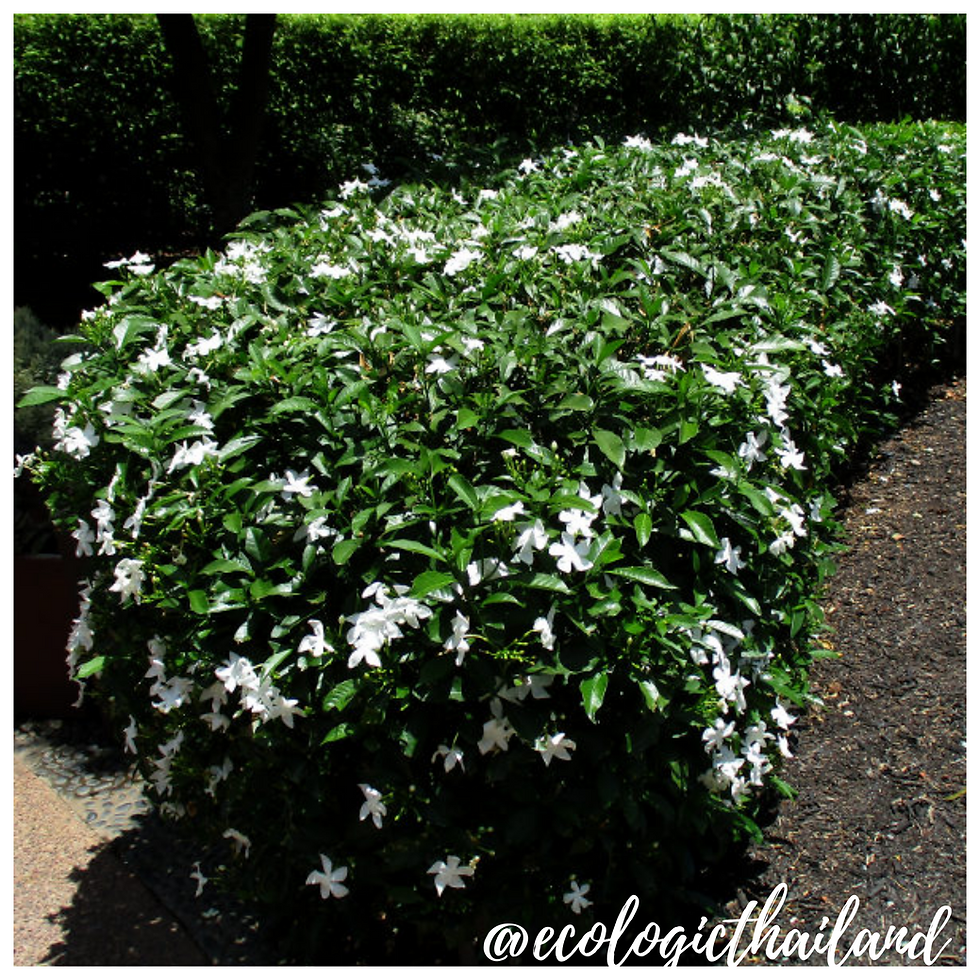Gardenia | Cape Jasmine
- Eco-Logic Resort
- Feb 16, 2021
- 3 min read
Phud-Son | พุดซ้อน | Gardenia jasminoides
Family: Rubiaceae - Genus: Gardenis

The gardenia plants can be found in the area of the Social Impact Shop of the Thai Child Development Foundation.
The Gardenia, also know as Cape Jasmine, Cape Jasmine Gardenia, Cape jessamine, is an evergreen flowering plant of the coffee family Rubiaceae. It originated in Asia. Wild plants range from 30 cm to 3 m high and have a rounded habit with very dense branches with opposite leaves, lanceolate-oblong, leathery or gathered in groups on the same node and by a dark green, shiny and slightly waxy surface and prominent veins.
With its shiny green leaves and heavily fragrant white flowers, it is widely used in gardens in warm temperate and subtropical climates. It has been in cultivation in China for at least a thousand years, and was introduced to English gardens in the mid-18th century.
The Cape Jasmine blooms from January to March.

THE SHRUB
The Gardenia is a shrub that ranges from 30 cm to 3 meters high in the wild, with cylindrical to flat branches that are furry at first becoming smooth. The leaves are arranged oppositely along the branches.

THE LEAVES
The leaves of the gardenia are 3-25 cm long by 1.5-8 cm wide and can be oblong or elliptic in shape. Their upper surface is smooth and shiny, or slightly furry along the primary veins, while the undersurface is slightly furry to smooth. Each leaf has 8 to 15 pairs of secondary veins.

THE FLOWERS
The flowers of the gardenia are solitary and terminal (arising from the ends of stems).
The white flowers have a matte texture, in contrast to the glossy leaves. They gradually take on a creamy yellow color and a waxy surface. They can be quite large, up to 10 centimeter in diameter, loosely funnel-shaped, and double in form. Blooming twice a year, they are among the most strongly fragrant of all flowers.
The flowers are edible.

THE FRUIT
After the gardenia blooms, the flowers are followed by small, oval fruit. The fruits are used to make medicine. In food, gardenia is used as a yellow food colorant.
CULINARY USES
Gardenia flowers can be eaten raw, pickled or preserved in honey. The fruits are also edible and used as yellow coloring for other fruits.
The unopened flower buds can be collected and boiled as a vegetable. Once opened the raw blossom can be used as a garnish or nibble.
In China, gardenia flowers are used to flavor herbal teas, often in combination with other herbs and flowers such as chrysanthemums.
NUTRITION
Nutrition: Some of the curative effects of gardenia are no doubt the result of the many phytochemicals found in the color pigments of gardenia fruits and flowers. Gardenia fruits contain carotenoids including crocin and crocetin. Aside from their ability to add a subtle yellow color to foods, the carotenoids have numerous health benefits.
TRADITIONAL MEDICINAL USE
NOTE: please take advice from a doctor if you are planning to use herbal medicine.
The fruit of the gardenia is used within traditional Chinese medicine to "drain fire" and treat certain febrile conditions, i.e. have an anti-inflammatory and antipyretic effect.
Gardenia is used for swelling (inflammation), liver disorders, diabetes, and other conditions, but there is no good scientific evidence to support these uses.
In Asia, gardenia is known as the 'happiness herb' because it is said to detoxify the liver, thereby releasing negative emotions. This may have led to the association between gardenia and love, healing and spiritually. Gardenia infused teas are known to detoxify the blood, relieve congestion and help lower LDL, or bad, cholesterol.
Externally, gardenia is used for skin inflammation, sprains and has blood staunching properties. It is still used in the traditional medicine of Vietnam, internally as a hemostatic agent.
INTO THE WILD: a down to earth experience

For guests and visitors to Paksong we organize weekly tours "The Edible Forest" and Foraging weekends: Into the Wild. We work with local guides to take you in the jungle of Paksong. After foraging, we will cook a meal with the ingredients, using bamboo together with you!
Come and join and learn about the abundance of food that nature gives us!
INTO THE WILD!

















Comments